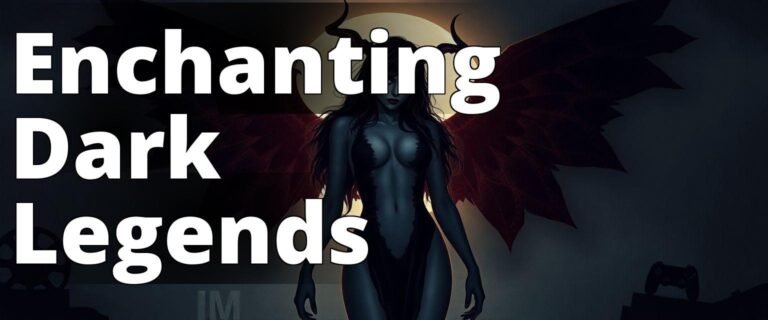The Myth of the Succubus
Have you ever wondered what lurks in the shadows of ancient folklore? The tales of mysterious and alluring creatures that enchant the imagination have captured human curiosity for centuries. Among these enigmatic beings is the succubus, a supernatural entity shrouded in mystery and seduction. What exactly is a succubus, and why has this figure endured in stories across cultures and generations? Lets embark on an evocative journey through time and myth to uncover the truth behind this captivating legend.
Understanding the Succubus Myth
Explore the intriguing world of succubi and their cultural significance through various eras.
– A succubus is a mythological female demon known for seducing men, often while they sleep, leading to draining their life force.
– The legend of the succubus originated in ancient folklore, evolving through different cultures and finding a significant place in medieval literature.
– To avoid a succubus, one might consider spiritual protection methods, such as prayer or maintaining a strong personal energy.
The Myth of the Succubus
The succubus myth is a rich tapestry woven into the fabric of folklore from cultures around the world. These creatures are often depicted as female demons who visit men in their dreams, seducing them and sometimes draining their life force. The very idea of a succubus taps into primal fears and desires, making it a compelling narrative that has persisted throughout history.
The allure of the succubus lies in its ability to embody both attraction and danger. This duality raises profound questions about the nature of desire and the risks associated with it. Can something so enticing truly be harmful, or is it merely a reflection of our own internal conflicts? As we delve deeper into the myth, consider how this balance between allure and peril plays out in human relationships and storytelling.

What Is a Succubus?
A succubus, in its most basic definition, is a demon or supernatural entity that takes on a female form to seduce men, typically during their sleep. The primary characteristic of a succubus is its seductive nature, using charm and allure to captivate its victims. In many legends, succubi are said to drain the life force or energy from men, leaving them weakened or even dead over time.
This concept is not just a tale to frighten or entertain; it serves as a metaphor for the dangers of unchecked desire and the consequences of succumbing to temptation. The succubus represents an exploration of human vulnerability and the potential destructiveness of seemingly irresistible attractions.
But why does the succubus take on a female form? Is it a reflection of societal views on femininity and sexuality, or does it speak to deeper fears about the power dynamics in relationships? As you ponder these questions, think about how the image of the succubus has influenced perceptions of gender and desire throughout history.
The Origins of the Succubus Legend
The origins of the succubus legend are as varied as they are ancient. The word “succubus” comes from the Latin “succubare,” meaning “to lie beneath,” which reflects the creature’s method of attackseducing men in their sleep. However, the idea of a supernatural seductress predates the term itself, with roots in ancient mythology.
One of the earliest known references to a succubus-like figure can be found in Mesopotamian mythology, with the demon Lilith. According to Jewish folklore, Lilith was Adam’s first wife who, after refusing to submit to him, was cast out of Eden and transformed into a night demon. She was said to seduce men and harm infants, embodying both allure and malevolence.

The succubus legend continued to evolve through the Middle Ages, influenced by religious and cultural shifts. It became intertwined with the fears and beliefs of the time, serving as a cautionary tale about the dangers of lust and the supernatural. By examining the transformation of the succubus myth across different eras and societies, we can gain insight into the universal themes that continue to resonate today.
The Succubus in Medieval Literature
During the Middle Ages, the image of the succubus became more defined and widespread, thanks in part to its inclusion in various literary and religious texts. Medieval writers used the succubus as a symbol of temptation and sin, often warning against the dangers of carnal desire and the power of demons.
In “Malleus Maleficarum,” a treatise on witchcraft written in the 15th century, succubi were described in detail, highlighting their seductive nature and their ability to steal men’s souls. This work, along with others like it, contributed to the widespread fear of witchcraft and demonic possession during this period.
Medieval scholars believed that succubi could not only seduce men but also collect their seed, which they would then give to incubimale demonsto impregnate women. This belief reflected societal anxieties about sexuality and reproduction, as well as the perceived threat of female sexuality.

The portrayal of succubi in medieval literature serves as a fascinating lens through which to view the attitudes and fears of the time. It raises questions about how these beliefs were used to control and marginalize certain groups, particularly women. How do these historical portrayals of the succubus mirror contemporary concerns about gender and power?
The Incubus: A Male Counterpart
While the succubus is often seen as a female demon, its male counterpart, the incubus, is equally significant in folklore. Incubi are said to visit sleeping women, seducing them and sometimes fathering children. Like succubi, incubi were believed to be responsible for a range of supernatural occurrences and ailments.
The incubus legend shares many similarities with that of the succubus, reflecting parallel fears and desires. However, the existence of both male and female demons highlights the universality of these themes, transcending gender and cultural boundaries. Incubi, like succubi, have been used to explain unexplainable phenomena and to caution against the dangers of unchecked desire.

What does the presence of both succubi and incubi in folklore suggest about human nature and the complexities of desire? Consider how these figures have been used to explore themes of power, control, and vulnerability in relationships. Do these stories offer valuable lessons, or are they merely reflections of societal anxieties and prejudices?
The Succubus in Modern Culture
In modern times, the succubus has continued to captivate the imagination, appearing in literature, film, and other forms of media. The allure of the succubus lies in its blend of seduction and danger, making it a compelling character for storytellers and audiences alike. From horror films to fantasy novels, the succubus has been reimagined and reinterpreted in countless ways.
One notable example is the character of Morrigan Aensland from the video game series “Darkstalkers.” Morrigan is portrayed as a powerful and seductive succubus, embodying both the traditional traits of the myth and a modern twist. Her character highlights the evolving nature of the succubus legend and its continued relevance in contemporary culture.

The succubus has also appeared in popular television shows like “Supernatural” and “Lost Girl,” further cementing its place in modern mythology. These portrayals often emphasize the complex nature of the succubus, blending elements of horror, fantasy, and romance.
As you explore the modern interpretations of the succubus, consider how these depictions reflect current cultural attitudes towards sexuality and power. What do they reveal about our ongoing fascination with the supernatural and the unknown? Do they challenge or reinforce traditional narratives about desire and danger?
How to Avoid a Succubus
While the existence of succubi may be the stuff of legend, the themes they represent are very real. In a metaphorical sense, avoiding a “succubus” involves recognizing the potential dangers of unchecked desire and the importance of maintaining healthy boundaries in relationships.
To “avoid a succubus,” one must be vigilant about the influences and temptations that can lead to destructive behavior. This involves self-awareness, communication, and a commitment to personal well-being. By understanding the allure and risks of certain attractions, individuals can navigate the complexities of desire with greater confidence and wisdom.

It’s also valuable to reflect on the broader implications of the succubus myth. How do these stories inform our understanding of gender, power, and morality? What lessons do they offer about the human experience and the nature of attraction?
In contemplating these questions, we can gain a deeper appreciation for the enduring power of folklore and its ability to illuminate the intricacies of human nature. Whether viewed as cautionary tales or reflections of societal fears, the legend of the succubus continues to intrigue and inspire.
Conclusion
The succubus legend is a captivating exploration of desire, danger, and the supernatural. From its ancient origins to its modern interpretations, the succubus serves as a powerful symbol of the complexities of human attraction and the potential consequences of succumbing to temptation.
As we delve into the history and mythology of the succubus, we are reminded of the universal themes that continue to resonate across cultures and generations. These tales challenge us to examine our own perceptions of desire and the balance between allure and peril. By understanding the succubus myth, we gain insight into the human condition and the timeless nature of our fears and fantasies.
For further reading on the fascinating world of mythology and folklore, feel free to explore Thin White Lies.
Insider Tip: When exploring myths and folklore, consider the cultural context and historical influences that shaped these stories. By understanding the origins and evolution of myths like the succubus, we can gain valuable insight into the human experience and the timeless nature of storytelling.
FAQ
What is a succubus in mythology?
A succubus is a female demon that seduces men in their dreams.
Who created the myth of the succubus?
The succubus myth dates back to ancient Mesopotamian and medieval folklore.
How do succubi affect their victims in stories?
They are said to drain life energy from men during intimate encounters.
Are succubi only found in Western mythology?
No, similar figures exist in various cultures around the world.
Can succubi be considered purely fictional?
Many view succubi as symbolic representations of sexual desires and fears.
What evidence supports the existence of succubi in history?
Historical texts and folklore describe succubi, but no concrete evidence exists.







